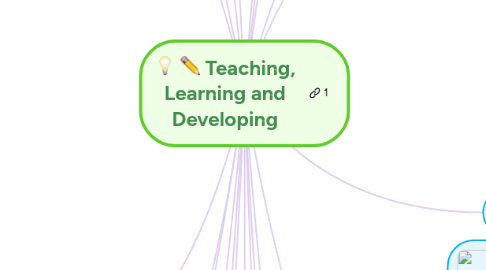
1. Postive Learning Environment
1.1. Planned lessons and set up of classroom
1.2. Atmosphere
1.3. classroom rules
1.3.1. Include students when making them
1.4. Reward and punishment
1.5. Classroom Management
1.6. Positive behaviour support
1.7. Calm, fair, consistent very important
2. Developmental Differences
2.1. Classroom Management
2.1.1. Organized
2.2. Vygotsky
2.2.1. Scaffolding
2.2.1.1. Proximal Development
2.2.1.2. able to assess what they learned
2.2.1.3. know there cues and decoding
2.2.1.4. break tasks to get feedback
2.2.1.5. connect to prior knowledge
2.3. other variables that make an impact
2.3.1. Space
2.3.1.1. Time
2.3.1.1.1. Language
2.4. Teach to ALL learning styles
3. Intellectual
3.1. Challenges
3.1.1. Special education
3.1.1.1. Indivudalized education plan
3.1.2. Mainstream
3.1.3. Inclusive
3.1.4. Cognitive skill profile
3.1.4.1. Outlines the behavioural and cognitive challegnes
3.2. Different types of learners
3.2.1. Visual
3.2.1.1. Music
3.2.1.1.1. Auditory
3.2.2. Logical
3.2.2.1. Kinesthetics
3.2.3. Reading/Writing
3.2.4. Auditory
3.3. Ability to adapt to ones environment
3.4. Ability to learn from one's experience
4. Socio-Cultural
4.1. "what is good for one is good for all"
4.2. Socio-economic has the greatest influence on achievement
4.2.1. Based upon education, income and occuption
4.2.2. Effects parenting style
4.2.2.1. Permissive style
4.2.2.2. Authoritative
4.2.2.3. Authoritarian
4.3. Religon
4.4. Visible Minorities
4.5. Aboriginals
4.6. Same sex couples
4.7. Single parent families
4.8. Stereotype threat
4.8.1. Fear existing in your eyes or others
4.9. Diversity
4.10. Multicultural
5. What I Learned
5.1. They are all connected,
5.1.1. All Coexist together
5.1.2. Overlap
5.1.3. Have an impact on Education
5.1.4. Impact on how a student learns
5.1.5. Impact on how a teacher teaches
6. Three learning goals I made at beginning of course/results:
7. Activities I Enjoyed/Learned from the Most:
8. 2 Instructional Approaches to Teaching
9. Dynamic Classroom Management
9.1. 3 Fundamental Understandings when Implementing DCM
10. Three fundamental cognitive functions for intelligence
11. Students who Receive Special Education
12. Social-Cultural Considerations
13. Planning
13.1. Reflective Practice
13.1.1. Practitioner
13.1.2. Scholarly Knowledge (Sockett)
13.2. Psychology
13.2.1. Central topics
13.2.2. Research process
13.2.3. Six Influential Theorists in Educational Psychology
13.3. Curricular Planning
13.3.1. Curricular planning process
13.4. Constructing a clear approach to teaching
13.4.1. Guidelines teachers should consider
14. Instructional decisions
14.1. Lesson Plans
14.2. Learning Objectives
14.3. Curriculum
14.4. Include students when making rules and routines in the classroom
15. Assessing Student Progress
15.1. Evaluation
15.2. Formative assessment
15.3. Testing
15.3.1. Multiple choice
15.3.2. Fill in the blanks
15.3.3. Short answers
15.3.4. true and False
15.3.5. Valid
15.3.6. Reliable
15.4. Rubic
15.5. Letting students know your expectations
15.6. Provide feedback
15.7. have different assessments
15.7.1. presentations
15.7.2. Tests
15.7.3. Papers
15.7.4. portfolios
15.7.5. Learning logs
16. Standardized achievement test
16.1. EQAO
16.1.1. Grade 3,6,9
16.1.2. Grade 10 Literacy test
